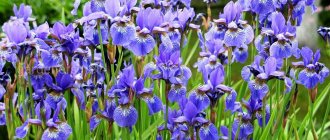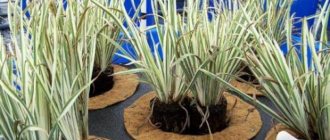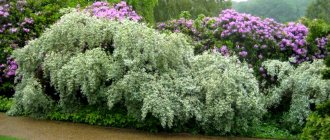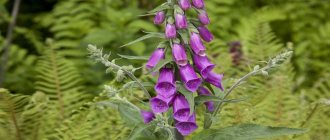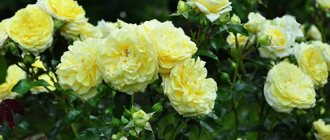To decorate plots of land, owners always carefully select beautiful ornamental shrubs that will delight you with their appearance and fragrant flowers for a long time. Such plants include Deutzia rough, which was brought to Europe by Dutch traders back in the 19th century.
Deytsia rough - description
A perennial plant with a lush crown and abundant flowering. Lovers of “beauty” in their garden choose the deutzia rough bush with double inflorescences, which look heavier and more abundant. Under the weight of the flowers, its branches bend and hang almost to the ground, forming a lush, voluminous bush, looking like a bride in a snow-white wedding dress.
Information for gardeners:
- Every year the shoots grow by 20-25 cm;
- flowering period - from May to July;
- the root system is represented by 1-2 long deep rhizomes and superficial fibrous ones;
- The cuttings are planted in open ground only after 1-2 years.
general information
Wild plants are typical for Mexico, the Himalayas, Japan and the adjacent Russian regions of the Far East.
Deutzia grows in almost any soil and does not require complex care. A plant frozen in winter actively grows young shoots within one season, restoring its previous size.
Deytsia
High decorative properties and unpretentiousness have allowed deutsia to occupy its niche in gardens around the world.
Attention! The undeniable advantage of the plant is its flowering immediately after the faded lilac, but before the mock orange and roses, which allows you to create a garden that blooms throughout the entire warm period.
Deytsia rough - characteristics
The plant belongs to the ornamental shrubs and has several dozen species that differ in external characteristics. Deutzia rough white looks especially impressive in landscape design. Characteristics:
- the bush reaches a height of 0.5 to 3.5-4 m;
- the length of the shoots is 2-2.5 m;
- the leaves are rough with a weak relief pattern of oval or ovoid veins from 3 to 8 cm.
- the foliage is rich green, turning yellow in autumn;
- the flowers are bell-shaped or star-shaped, collected in racemes up to 15 cm long;
- The color of the petals, depending on the variety, ranges from white and pale pink to crimson;
- Deutzia rough begins to bloom only in the 3rd year after planting;
Variety of forms and types of action
Deytsia is thermophilic. It is more suitable for a mild climate without harsh winters. The culture is quite widespread in China, in the mountainous regions of the Himalayas, Korea, and Japan. In the Far East the most frost-resistant types of deytia are found:
- Amurskaya;
- Smooth.
Deytsia smootha
These rare species are protected in Russian nature reserves.
The best varieties for planting in our region
In the climatic zone of the Moscow region and Leningrad region, with proper wintering, the following species grow well:
- Rough or star-shaped deutzia (late variety, with large white flowers);
- Graceful (decorative appearance with a height of 50 cm to 1.5 m, flowering duration 35 days);
- Deytsia Schneider (in its homeland in China these are tall bushes up to 2 m, in the Moscow region a little more than 1 m).
Experienced flower growers and exotic lovers grow the following varieties:
- Deytsia Krupnotsvetkovaya (profusely flowering hybrid with large white flowers);
- Purple Deutia (tall plant with bright purple flowers);
- Magnificent or lush (abundant snow-white flowering, considered one of the most beautiful species).
Purple deutia
Some varieties of deutia can only be grown in greenhouses or southern regions.
The crown of the deutia can be spreading and erect. The latter form without flowering is sometimes confused with honeysuckle. The height of bushes of different types is from 40 cm to 4 m. Decorative species do not exceed 1.8 m. Varieties of deutsia with double and simple flowers have been bred. Various hybrid varieties that are more resistant to frost and drought.
With proper care, the deutzia will become a real decoration of your site. The fast-growing plant is excellent for landscape design, creating compositions with flowers, and mixborders.
Deytsia rough - varieties
In the wild, a shrub with rough leaves is found in China and Japan, and in Europe it is used as a garden crop. Varieties:
- "Candidissima"
. Snow-white flowers collected in racemes up to 15 cm in length. - "Pride of Rochester"
. Deytsia rough terry with white flowers. After flowering, seed pods are not formed. - "Marmorata"
. A spotted pattern on the leaves is yellow or white. - Deytsia rough "Captive"
. Terry inflorescences of white and pink shade are especially valued for decorating front gardens. - "Codsel Pink"
. Arching shoots with bright green foliage and pale pink flowers.
Features of planting
Successful cultivation of shrubs is impossible if mistakes are made at the planting stage. They will not allow the plant to fully develop and bloom beautifully, since all its strength will be spent on surviving in unfavorable conditions.
How to choose a seedling?
You should only buy planting material from a safe place.
There should be no damage or signs of any diseases on the shoots of the plant.
The root system of the shrub should be protected from drying out with a clay mash or burlap. If you need to transport seedlings far, you should choose only those that have a closed root system.
If the plant is slightly damaged after transportation, then the broken shoots are cut off and the wounds are rubbed with activated carbon. You should not plant a damaged bush, as this will only weaken it and impair its survival rate.
Which place to choose?
Deutzia is a light-loving crop and cannot grow in partial shade or shade. The place where it will be planted must be protected from strong winds. Soil moisture needs to be average; stagnation of water has a detrimental effect on the shrub.
The plant thrives ideally on loose soil with a slightly alkaline reaction. When planting shrubs near the walls of the house, take into account that water flowing from the roof should not fall on it.
The least whimsical is pink deutzia, as it can tolerate light partial shade.
Landing
The shrub should be planted in the spring so that it has time to fully take root by winter. For the plant, dig a hole 50 cm deep and 20-30 cm wider in diameter than the root system of the seedling.
A drainage layer 10 cm thick of crushed brick or expanded clay is poured onto the bottom. Next, pour 15 cm of soil, install the plant and cover its roots.
They must first be straightened so that the roots do not tuck and can quickly begin to fully develop. It is unacceptable to bury the root collar. It should remain flush with the ground surface.
The ideal soil for filling a planting hole would be a composition of 2 parts humus and sand and 1 part peat compost.
Some gardeners also recommend adding 100 g of nitrophoska to the composition. Official agricultural technology does not provide for this.
Deytsia: I say yes!
Deytsia rough - planting
In order for the “eastern beauty” to please with its flowering for as long as possible, it is necessary to choose the right healthy cutting and plant it taking into account all the preferences of the plant. The deutzia rough bush, planting and caring for which during the rooting period requires special attention, will not bring much trouble to the owners in the future.
Landing technique:
- Dig a hole 40 cm deep. For depleted soils, this figure increases to 50-60 cm.
- The plant is carefully inspected, dry and rotten roots are removed.
- 12-24 hours before planting, the action should be placed in water with a root formation stimulator.
- The tangled roots are straightened out.
- Before planting the cuttings, fertilizers are added to the hole - compost and Nitrophoska.
- The root collar should not be deeply buried in the ground.
- Compact the soil around the plant a little.
- Water. It is unacceptable for the earthen clod to dry out during the rooting stage.
Growing and care
Growing deutia is not difficult - the shrub has small requirements for soil and position, is characterized by vigorous growth and does not require special care.
Choosing a landing site
Cultivation of deutia should be carried out on soils:
- moderately humid;
- loose;
- humus;
- The soil acidity level is neutral or slightly acidic.
It is worth enriching the area before planting with rotted compost, which stimulates growth and increases resistance to disease.
Deutzia grow well in sunny or semi-shaded places. Light shading does not interfere with beautiful and abundant flowering. Cultivation can be done in groups or individually.
When to plant?
Deytsia is imprisoned in 2 terms:
- in spring - from March to April;
- in autumn - from August to November.
Planting dates are selected depending on the possibilities and conditions:
- Seedlings with a closed root system (purchased in a container) can be planted when the soil is not frozen (practically from March to November).
- If it is not possible for regular watering (which is very important for recently planted plants), it is better to choose early spring or (even better) autumn, when there is the most moisture in the soil and evaporation is not so intense.
Landing
The plant is easy to accept and does not require special care.
Work progress:
- Weeding the soil - we get rid of weeds so that they do not compete with the action for water, nutrients, and sunlight.
- We dig a hole with a diameter of 30 cm and a depth of 40 cm (if the seedling is in a container, in accordance with its size). The hole should be large enough to plant the plant freely and completely cover the root system with soil.
- The soil on the bottom and walls of the pit should be lightly loosened with a pitchfork. This will help the plant take root easier and deeper.
- Preparing plants. You need to soak the roots for 20 minutes. in water. The entire pot with the seedling is placed in a bucket of water.
- If, after removing the plant from the container, it turns out that the roots are very compacted and twisted, then the root ball should be cut in several places using scissors or a sharp knife. This will straighten out the roots and allow the plant to take root more easily.
- Trimming. We shorten the shoots by 1/3, remove dry leaves and damaged shoots. Pruning will make the plant look more attractive and prevent fungal diseases.
- Landing. Add a layer of fresh soil to the bottom of the hole and place the root ball in the hole, observing the required planting depth. This task will be made easier by placing a stick around the edges of the hole (you can use a shovel), which will determine the appropriate depth for the root ball.
Planting depth is very important : do not plant the plant too deep or too shallow. The root collar - the part of the plant between the roots and the trunk - should be at ground level. The plant from the container is planted at the same depth at which it grew in the container (perhaps 3-5 cm below the surface of the ground).
- Fill the hole with soil. Lightly compact the soil and add more soil if necessary.
- You can make a wide hole around the plant, which will retain water and facilitate its flow to the roots.
- Water generously, especially if planting is done in the middle of the season. After watering, the soil may settle, exposing the roots; you need to top up the soil. After planting, you can spread agrofibre or use mulching, this will reduce the need for weeding.
It is important to water the deutia regularly in the first 2 years of cultivation.
An important rule for watering a young seedling : it is better to water once and abundantly than often and sparingly.
And that's why:
- Frequent and weak watering causes the plant's roots to form shallow because they find moisture in the upper parts of the soil.
- If plants are watered rarely, but a lot, the opposite is true: they take root deeper.
The result: in later years the plants do not need to be watered outside of periods of drought.
Reproduction
Deutia can be propagated either from green cuttings, which quickly take root, or by layering.
Propagation of action by cuttings - progress of work:
- Cuttings are harvested from the tops of green shoots of bushes, cut into pieces 10-15 cm long. The procedure is carried out in the morning.
- After cutting, they are placed in water. The lower leaves are torn off.
- The cuttings are dipped in a rooting agent.
- Prepared cuttings are planted in containers filled with a mixture of peat and sand or perlite in a 1:1 ratio. The container should be covered with perforated film to maintain high humidity.
- At the beginning of germination, seedlings should not be exposed to direct sunlight and soil moisture should be constantly monitored.
- Cuttings root very easily. After rooting, which usually lasts 5 weeks, gradually reduce watering and ventilate the container more often.
- Rooted cuttings are planted in pots with a diameter of 8 cm.
- In the spring, Deutia seedlings are planted in open ground. Young plants grow quite quickly.
Propagation can also be carried out by digging up rooted shoots that have already separated from the mother plants.
Generative propagation of Deutia from seeds under amateur conditions is very difficult and is usually not carried out.
Wintering, frost resistance
Deutzia is not a completely frost-resistant shrub; most species are characterized by low resistance to low temperatures. Therefore, planting and caring for action in the Moscow region and Leningrad region must include winter shelter. In severe winters, the bushes freeze to the border of snow or soil, but have the ability to quickly regenerate - new shoots grow from undamaged ground shoots, quickly restoring the crown.
Despite this, it is worth giving the bush a position protected from the frosty wind or covering the bush with spruce branches. If the shoots are frozen, they are cut back to a healthy place.
Deutia varieties with low frost resistance:
- "Candidissima"
- "Strawberry Fields"
- dwarf variety "Pride of Rochester".
The variety most resistant to low temperatures is “Plena”.
Trimming
The first pruning is done in the spring immediately after planting the bush, shortening the shoots by 1/3 of the length. If the bush is planted in the fall, you need to wait until spring to prune. Thanks to the first pruning, the bush will be well accepted in its new position and acquire a compact crown.
Actions reach different sizes - a maximum of 3 meters. Further pruning is carried out as follows:
- During the first three years , pruning should only cover shoots located above the first new branch.
- In later years of cultivation , it is worth carrying out anti-aging pruning every 2-3 years. It is necessary to thin out the center of the bush, providing optimal access to light. You also need to systematically remove dry, damaged branches.
- It is better to prune shoots that are damaged or frozen after winter after flowering.
Watering
During periods of increased drought, you must not forget about watering; deutia has a very shallow root system. In this case, it is necessary to provide sufficient water to replenish the lack of moisture. Because these shrubs are drought intolerant, they should not be planted with other flowers that can absorb moisture. This will result in weaker flowering. In case of shortage of irrigation water, it is worth pruning the lower shoots, which leads to low tillering and thus covers the base of the bush, reducing evaporation.
Diseases and pests
Deutzia is a plant that is extremely resistant to diseases and pests. The bush is sometimes attacked by aphids and leaf rollers. A very good method of pest control is to remove damaged leaves. This will reduce the number of leaf rollers.
Action diseases:
- Powdery mildew . _ _ _ Appears on the leaves as a white coating. Grows well at high temperatures and high humidity. The affected parts of the plant die. To prevent the spread of the disease, it is necessary to remove the infected parts of the bush and then treat it with a fungicide, such as Topaz. It is also worth taking care of proper care in advance, choosing healthy and resistant varieties.
- Fungal diseases such as rust - give characteristic symptoms in the form of round, rusty spots. Rust requires high temperatures and humidity to develop. In this case, you need to react quickly by removing and burning the infected leaves. Then the bush is sprayed with fungicides several times (according to the instructions).
It is worth doing thinning pruning more often and removing weeds, which reduces the susceptibility of the bush to diseases.
How to care for deytia rough?
The plant requires not only proper watering, but also pruning of shoots, regular application of fertilizers, and preparation for wintering. All varieties are similar in their requirements, but some have differences. For example, Deutzia rough "Codell pink" prefers more acidified soil than other representatives.
Deytsia rough - watering
The shrub is a drought-resistant plant. For full development, it requires infrequent watering about 2-3 times a month. Each plant needs about 10-15 liters. water. In dry summer conditions, the number of waterings increases to 3-4 times a month, and water - up to 20 liters. With frequent rains, additional moisture is reduced. At the same time, organic fertilizers are also applied.
Deytsia rough - pruning
After wintering, the shrub needs rejuvenation. Due to old, dry or damaged shoots, young branches may not grow well. At the same time, the bush loses its decorative properties. Pruning is carried out 2-3 times a year:
- In the spring
. The plant is carefully inspected for frozen branches. They stand out from the general mass by the absence of young buds. In this case, approximately a quarter of all shoots are removed. This gives impetus to the growth of young and healthy shoots. - From March to September
. They also prune if the bush has become too dense. To form an attractive crown, you are allowed to remove branches at your discretion, and not just dry ones. For example, Deutia rough Candidissima looks good with both cascading curved branches and erect ones. To do this, in early spring the shoots are shortened slightly throughout the entire crown. - In autumn
. After flowering is completed, it is necessary to trim the shoots to the first good bud. Before the onset of cold weather, the plant must gain strength and lay the foundation for flowering next summer. - Anti-aging pruning
. 7-8 years after planting the shrub, when flowering is not as abundant as before, all shoots are completely removed. In this case, 10-20 cm are left above the ground.
Pests and diseases
All types of deutia are resistant to typical garden diseases and pests. Sometimes the bumblebee proboscis eats leaves. If a pest is detected, the bushes are sprayed with a 15% phthalophos solution.
From the second half of summer, the plant is regularly checked for the presence of horned caterpillars, aphids, and mites. To combat insects, use solutions of Decis or Bitoxibacillin, diluted strictly according to the instructions.
The only disease that threatens the action is root rot. The disease occurs due to improper care of the plant: waterlogging of the soil, stagnation of water in the cold season or early spring. Most often, with severe damage, the bush dies, so planting deutzia without drainage is unacceptable.
Deytsia rough - wintering
With the arrival of autumn, it is necessary to take care of preparing the plant for frost. The deutzia rough shrub has good winter hardiness, quite suitable for the middle zone climate. All the same, in order for the plant not to freeze, it needs to be prepared for cold weather and snow. Preparing for winter:
- At the end of summer they stop watering.
- In September, it is necessary to cover the soil around the bush with waterproof material.
- When the temperature drops below 10°C at night, the branches need to be bent to the surface of the ground and secured with staples. Some varieties can be easily damaged by mechanical stress, for example, deutzia rough “White”, so they are not touched.
- When the daily temperature drops to 0°C, shoots on the ground surface are insulated with fallen leaves, dry pine needles, and sawdust.
- Small bushes can be covered with branches of spruce branches, which will protect the plant from snow.
Preparation and shelter for the winter
Perhaps the biggest problem for summer residents of the Urals is ensuring good conditions for wintering. The younger the bush, the more it needs insulation.
In order for the plant to survive winter frosts well, you should do the following:
- Mulch the plant's trunk with a thick layer of fallen leaves or straw. In addition, a layer of coniferous spruce branches laid at the base of the bush will help retain heat.
- Cover the plant with burlap or agrofibre, wrap it on top with non-woven material, which is removed only at the end of March - beginning of April.
Deytsia rough - reproduction
Several methods are used to obtain new shrubs. Some of them are not popular due to the labor-intensive process, while others, on the contrary, are easy and inexpensive. Deytsia reproduces in the following ways:
- Seeds
. They are collected at the end of September, and in the spring they are planted in boxes with prepared substrate. The seeds are sprinkled with river sand to prevent moisture from evaporating. Future shoots are covered with film. In 1-2 months. The seedlings are transferred to open ground. - Propagation by cuttings
of Deytia rough. At the end of May, 10-20 cm of young shoots are cut. The lower cut is treated with a root formation stimulator and buried in the soil in the greenhouse. After the shoots appear, the cuttings are transferred to open ground for growing. - By layering
. In spring, tilt the young shoot to the ground and dig it into a hole 5 cm deep. Sprinkle peat on top and water regularly. Insulate the future cuttings for the winter. The next year, after the appearance of young shoots, separate them from the adult plant. - Dividing the bush
. The bush is dug up and divided into 2-3 parts with a sharp knife. Each of them is planted in a new place. - Separation of root shoots
. In the spring, new shoots growing from the ground are dug up and replanted.
Warm “hut” for activities
In the conditions of central Russia, the Moscow region and the more northern Leningrad region, pink deutzia requires reliable shelter for the winter.
The bushes are bent to the ground and fixed with a frame. Spruce spruce branches, dry leaves, and straw are placed on top. Spunbond is placed on top - a material that allows air to pass through and retains heat. The covering is completed with a layer of polyethylene. It will prevent moisture from getting inside.
Do not allow heavy snow accumulation on the shelter, as this can damage or break branches. The “hut” itself needs to be checked and corrected.
Deytsia rough in landscape design
The variety of shapes and colors allows you to create incredibly beautiful front gardens on your personal plots. Among the striking examples are the following placement options:
- Deutia rougha Plena is often planted near the house as a bright accent.
- A white bush will complement the green composition created by trees and bushes.
- Tall bushes are used as single or complex garden compositions.
- Low-growing shrubs are used to create lush borders.
Pruning bushes and preparing them for wintering
Bushes are pruned annually at the end of April and in the fall, after the plants have finished flowering. In the spring, perennials are inspected for damaged or broken branches and carefully removed. The ends of shoots that are frozen in winter and branches that grow inside the crown should be trimmed. Branches that have faded in summer are cut back to young shoots, and new shoots themselves are shortened by 1/3 of their length. Thanks to the pruning procedure, the branches will bush better and flower buds will begin to form on them. To prevent the bush from aging, when it reaches the age of five, it is rejuvenated once every 36 months. To do this, old branches are removed to the very base. Sometimes all the branches are cut off at the root so that the plant is completely rejuvenated. If all procedures are followed correctly, deytsia will bloom every summer, starting from the second year of life.
The most dangerous time of year for perennials is winter. Therefore, you should prepare the shrub for the cold period in advance. In areas with snowy, moderate winters, the branches of the action are simply bent to the ground for this purpose. But in the conditions of the Moscow region, the perennial will need more serious shelter. After pruning, the young bushes are not only bent to the ground, a wire frame is installed above them and covered with spruce branches or a layer of fallen dry leaves. Polyethylene is placed on top of the frame to protect the plant from moisture. This method is not suitable for adults. You will first need to tie the bush with twine, then wrap it in spunbond or a piece of burlap. In such “clothes” the plant will be warm and at the same time its buds will not sap, but will develop normally in the spring. Open the perennial after all the snow has melted.
